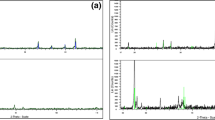Abstract
Contact angle for millimeter-size drops of lead on {100} and {110} surfaces of monocrystalline copper and on polycrystalline copper was determined by means of dispensed drop technique at 450 °C under He-H2 atmosphere. It was demonstrated that the wetting anisotropy (a difference between contact angles on differently oriented substrates) is not exceed a few degrees. Spreading kinetics was found to be different for the first and second drops deposited on each substrate. This result was interpreted as an effect of a lead precursor film formation on the substrate surface. Molecular dynamics simulations of the lead drop spreading over {111}, {100}, and {110} surfaces of monocrystalline copper confirm the weak anisotropy of equilibrium contact angle and a formation of lead precursor film on copper surface in front of wetting line.












Similar content being viewed by others
References
Yu.Z. Povstenko, Anisotropy of Wetting and Spreading, J. Math. Sci., 1993, 64(3), p 890–898
D. Chatain, Anisotropy of Wetting, Annu. Rev. Mater. Res., 2008, 38, p 45–70
V.A. Presnov and A.P. Vyatkin, Wetting of Germanium by Indium and Solder Contacts of Semiconductors with Metals, Surface Phenomena in Metals and Solders and Their Role in Processes of Powder Metallurgy, Academy of Sciences of the Ukrainian SSR Press, Kiev, 1961, p 91–99 (in Russian)
A.P. Vyatkin and B.A. Selivanov, Production of Flat Alloyed Contacts with Germanium, Izv. Visch. Ucheb. Zav. Fizika, 1958, 5, p 60–64 (in Russian)
R.W. Olesinski, N. Kanani, and G.J. Abbaschian, The Ge-In (Germanium-Indium) System, Bull. Alloy Phase Diagrams, 1985, 6(6), p 536–539
N.F. Grigorenko, V.S. Zhuravlev, N.A. Krasovskaya, O.I.Tihomirova, V.V. Shishkov, Capillary Properties of an Indium-Tin Liquid Phase of Diffusion-Hardening Solders for a Germanium Solder, Capillary and Adhesion Properties of Melts, Naukova Dumka, Kiev, 1987, p 143–148 (in Russian)
B. Ressel, K.C. Prince, S. Heun, and Y. Homma, Wetting of Si Surfaces by Au–Si Liquid Alloys, J. Appl. Phys., 2003, 93(7), p 3886–3892
Z. Shi and P. Wynblatt, A Study of the Pb/Al(100) Interfacial Energy, Metall. Mater. Trans., 2002, A33, p 2569–2572
Z. Shi, J.B. Lowekamp, and P. Wynblatt, Energy of the Pb{111} Parallel to Al{111} Interface, Metall. Mater. Trans., 2002, A33, p 1003–1007
G. Rao, D.B. Zhang, and P. Wynblatt, A Determination of Interfacial Energy and Interfacial Composition in Cu-Pb and Cu-Pb-X Alloys by Solid-State Wetting Measurements, Acta Metall., 1993, 41, p 3331–3340
N. Eustathopoulos, M. Nicholas, and B. Drevet, Wettability at High Temperatures, Elsevier, Amsterdam, 1999, p 418
P. Protsenko, A. Terlain, and N. Eustathopoulos, Wetting of W by Liquid Pb and PbLi Alloys and Surface Interactions, J. Nucl. Mater., 2007, 360, p 265–271
P. Protsenko, J.-P. Garandet, R. Voytovych, and N. Eustathopoulos, Thermodynamics and Kinetics of Dissolutive Wetting of Si by Liquid Cu, Acta Mater., 2010, 58, p 6565–6574
S. Plimpton, Fast Parallel Algorithms for Short-Range Molecular Dynamics, J. Comp. Phys., 1995, 117, p 1–19
M.S. Daw, S.M. Foiles, and M.I. Baskes, The Embedded-Atom Method: A Review of Theory and Applications, Mater. Sci. Rep., 1993, 9, p 251–310
J.J. Hoyt, J.W. Garvin, E.B. Webb, III, and M. Asta, An Embedded Atom Method Interatomic Potential for the Cu–Pb System, Model. Simul. Mater. Sci. Eng., 2003, 11, p 287–300
H.S. Lim, C.K. Ong, and F. Ercolessi, Stability of Face-Centered Cubic and Icosahedral Lead Clusters, Surf. Sci., 1992, 269(270), p 1109–1115
S.M. Foiles, M.I. Baskes, and M.S. Daw, Embedded-Atom-Method Functions for the fcc Metals Cu, Ag, Au, Ni, Pd, Pt, and Their Alloys, Phys. Rev. B, 1986, 33, p 7983–7991
D.R. Heine, G.S. Grest, and E.B. Webb, III, Surface Wetting of Liquid Nanodroplets: Droplet-Size Effects, Phys. Rev. Lett., 2005, 95(10), p 1–4
E.B. Webb, III, J.J. Hoyt, and G.S. Grest, High Temperature Wetting: Insights from Atomistic Simulations, Curr. Opin. Solid State Mater. Sci., 2005, 9(4–5), p 174–180
E.B. Webb, III, J.J. Hoyt, G.S. Grest, and D.R. Heine, Atomistic Simulations of Reactive Wetting in Metallic Systems, J. Mater. Sci., 2005, 40(9–10), p 2281–2286
E.B. Webb, III, G.S. Grest, and D.R. Heine, Precursor Film Controlled Wetting of Pb on Cu, Phys. Rev. Lett., 2003, 91(23), p 2361021–2361024
G.L.J. Bailey and H.C. Watkins, Surface Tension in the System Solid Copper-Molten Lead, Proc. Phys. Soc.B, 1950, 63, p 350–358
C. Cohen, Y. Girard, P. Leroux-Hugon, A. L’Hoir, J. Moulin, and D. Schmaus, Surface Diffusion of Pb on (100) Cu: Coverage Dependence and Influence of Ordered-Phase Formation, Europhys. Lett., 1993, 24, p 767–772
D. Chatain, V. Ghetta, and P. Wynblatt, Equilibrium Shape of Copper Crystals Grown on Sapphire, Interface Sci., 2004, 12, p 7–18
L. Felberbaum, “Microstructure and Embrittlement of Leaded Copper Alloys,” PhD Thesis, Lausanne, EPFL, 2005
Acknowledgments
The authors are gratefully acknowledged Dr. S. I. Prokofjev and Prof. B.B. Straumal from ISSP RAS (Chernogolovka) for kindly supplied copper monocrystals. Financial support of Russian Foundation for Basic Research under Grant No. 11-08-01244-a is kindly acknowledged. The calculations were performed by using ‘Chebyshev’ SKIF MSU supercomputer.
Author information
Authors and Affiliations
Corresponding author
Additional information
This article is an invited submission to JMEP selected from presentations at the Symposia “Wetting, soldering and brazing” and “Diffusion bonding and characterization” belonging to the Topic “Joining” at the European Congress and Exhibition on Advanced Materials and Processes (EUROMAT 2011), held September 12-15, 2011, in Montpellier, France, and has been expanded from the original presentation.
Rights and permissions
About this article
Cite this article
Timoshenko, V., Bochenkov, V., Traskine, V. et al. Anisotropy of Wetting and Spreading in Binary Cu-Pb Metallic System: Experimental Facts and MD Modeling. J. of Materi Eng and Perform 21, 575–584 (2012). https://doi.org/10.1007/s11665-012-0184-5
Received:
Revised:
Published:
Issue Date:
DOI: https://doi.org/10.1007/s11665-012-0184-5




